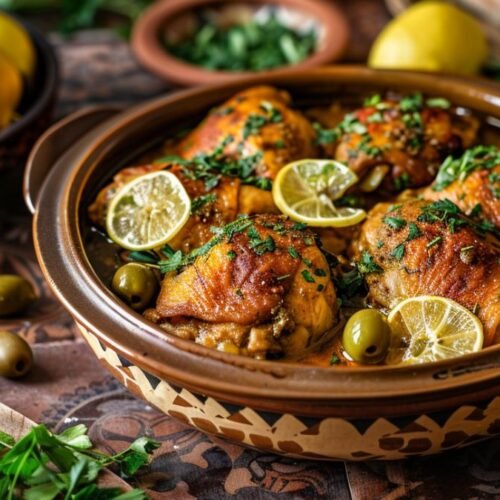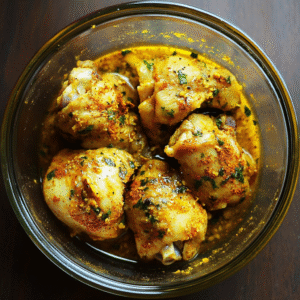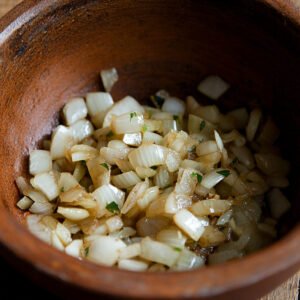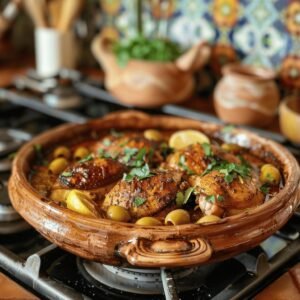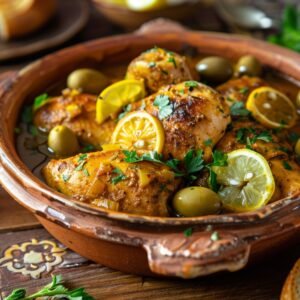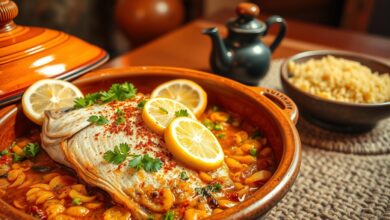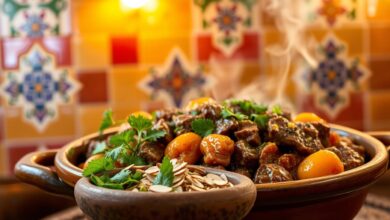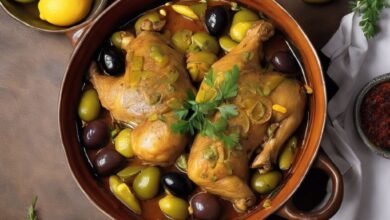
Discover the rich, comforting taste of a traditional Moroccan chicken tagine, slow-cooked with preserved lemon and olives. This dish is a staple of Moroccan cuisine and a celebration of warm, bold spices.
Experience an unforgettable journey of taste with our Moroccan Chicken Symphony — an exquisite creation inspired by ancient traditions, slow-cooked to perfection, and infused with the bold soul of North African flavors.
Moroccan Chicken Tagine: A Dance of Warm Spices and Zesty Citrus
Envision a dish that marries the tenderness of braised chicken with the brightness of preserved lemon and the briny notes of green olives — all slow-simmered in a clay tagine. This isn’t just a meal; it’s a culinary embrace from Morocco, crafted to awaken your senses and soothe your soul.
Ingredients for a Moroccan Chicken Tagine
We reimagined the traditional tagine using only the most aromatic spices: earthy cumin, golden turmeric, fiery ginger, and just a whisper of cinnamon.
The chicken, marinated and slow-cooked, absorbs every nuance. Sliced onions melt into the sauce, garlic deepens the base, and the combination of preserved lemon, green olives, and golden raisins delivers a tangy-sweet harmony that lingers long after the final bite.
How to Cook an Authentic Moroccan Chicken Tagine
Cooking this dish is an act of culinary mindfulness. Whether you’re using a clay tagine or a humble skillet, the slow and gentle simmering allows every ingredient to release its essence. This is more than cooking — it’s storytelling through flavor, honoring centuries of Moroccan home cooking.
Make It Your Own
Be the storyteller in your kitchen. Add a pinch of saffron for a royal twist. Prefer it spicy? A dash of harissa will ignite the dish with gentle heat. Vegetarian? Replace chicken with chickpeas and seasonal vegetables.
The Moroccan Chicken Symphony is a canvas — and you are the chef-composer.
Serving and Preservation
Traditionally served with warm khobz (Moroccan bread), this dish also pairs beautifully with couscous or lemon rice. Let it rest before serving to allow flavors to deepen. Refrigerate leftovers for 2–3 days — it tastes even better the next day.
Moroccan Chicken Tagine with Preserved Lemon & Olives
Equipment
- 1 Traditional clay tagine or heavy-bottomed pot
- 1 Mixing bowl
- 1 Chef’s knife
- 1 Chopping board
- 1 Wooden spoon
Ingredients
- 5 Pieces Chicken thighs Bone-in, skin-on preferred
- 2 Tbsp Olive oil Extra virgin
- 1 Large Onion Cut into wedges
- 3 Cloves Garlic Finely minced
- 1 Whole Preserved lemon Guartered, seeds removed
- 100 grams green olives Pitted
- 1/2 Bunch Fresh cilantro Chopped
- 1/2 Bunch Fresh parsley Chopped
- 1/2 Teaspoon Ground cumin
- 1 Teaspoon Ground ginger
- 1/2 Teaspoon Paprika Sweet or smoked
- 1/2 Teaspoon Turmeric
- 1/2 Teaspoon Ground black pepper or to taste
- 1/2 Teaspoon Salt or to taste
- 200 ml Water
- 1/2 Whole Lemon
Instructions
- Prepare the Marinade: In a bowl, mix olive oil, ginger, cumin, paprika, turmeric, pepper, salt, garlic, and lemon juice. Coat the chicken thighs and let marinate for at least 1 hour (overnight recommended).
- Sauté the Onions: In your tagine or pot over medium heat, add a bit of oil and sauté chopped onions until translucent.
- Add Chicken & Herbs: Place marinated chicken over the onions. Scatter preserved lemon quarters and olives around. Sprinkle with chopped parsley and cilantro.
- Add Water & Simmer: Pour water gently around the tagine edges. Cover and cook on low heat for 1 hour and 15 minutes, until chicken is tender and sauce is reduced.
- Serve: In the tagine, garnished with fresh herbs if desired. Enjoy with warm Moroccan bread for dipping, or serve alongside couscous.
Notes
- Tagine vs. Skillet: While a traditional clay tagine brings authentic slow-cooking benefits, this recipe can also be made in a heavy-bottomed skillet or Dutch oven with a lid.
- Preserved Lemon Substitute: If preserved lemons aren’t available, thin slices of regular lemon can be used. However, the flavor will be milder and slightly more bitter. Increase salt slightly to compensate.
- Chicken Cut: This recipe uses 5 chicken thighs (bone-in, skin-on) for optimal flavor and tenderness. You may substitute with drumsticks or mixed parts, adjusting cooking time slightly.
- Spice Adjustment: The listed spices reflect traditional Moroccan flavor. Feel free to adjust according to preference—more cinnamon for warmth, or chili flakes for heat.
- Olives Tip: Use pitted green olives. Moroccan varieties like Picholine are ideal, but any brined green olive works well.
- Make Ahead: The dish tastes even better the next day as the flavors meld. It can be made up to 24 hours in advance and gently reheated before serving.
- Serving Suggestion: Traditionally served directly from the tagine with Moroccan khobz (flatbread) to scoop up the sauce. For a more complete meal, serve with steamed couscous or rice.
- Storage: Refrigerate leftovers in an airtight container for up to 3 days. Reheat gently on the stove to preserve texture and moisture.
- Freezing: This dish freezes well without the olives. Add fresh olives after thawing and reheating to preserve their texture.
